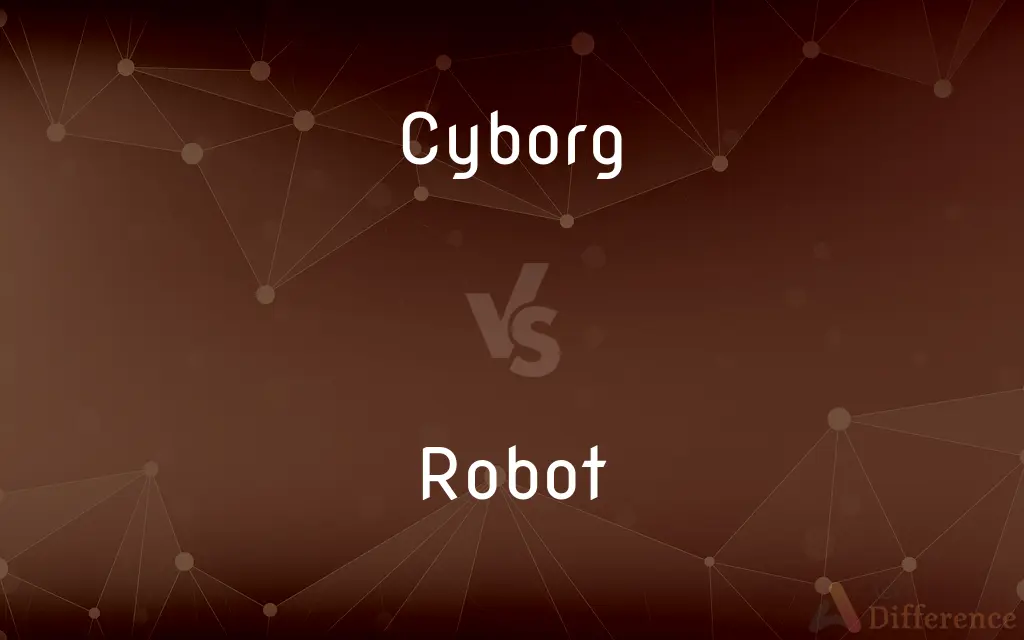Cyborg vs. Robot — What's the Difference?
By Maham Liaqat & Urooj Arif — Updated on March 21, 2024
A cyborg is a being with both organic and biomechatronic body parts, enhancing or restoring human capabilities, whereas a robot is a fully artificial, programmable machine designed to perform tasks autonomously.

Difference Between Cyborg and Robot
Table of Contents
ADVERTISEMENT
Key Differences
Cyborgs integrate technology with biological organisms, often to improve life quality or enhance abilities, such as prosthetic limbs or implanted devices enhancing senses. Robots, on the other hand, are entirely constructed entities, designed to execute tasks without human intervention, ranging from industrial automation to service roles.
While cyborgs represent a fusion of human and machine, maintaining elements of human consciousness and decision-making, robots operate based on pre-programmed algorithms and artificial intelligence, lacking any inherent organic or emotional components.
Cyborg enhancements are typically focused on specific functionalities, like restoring lost senses or augmenting physical capabilities, enhancing the human experience. Robots are designed with a wide range of capabilities, from simple repetitive tasks in manufacturing to complex problem-solving in AI research.
The development of cyborg technology often revolves around medical and bioengineering fields, aiming to address human disabilities or health conditions. Robotics, conversely, spans a broader spectrum of engineering, computer science, and even entertainment, focusing on creating versatile and efficient machines.
In society, cyborgs challenge our understanding of human identity and the natural-technological boundary, raising ethical and philosophical questions. Robots, while also presenting ethical debates, mainly revolve around economic, safety, and social integration issues, such as job displacement and human-robot interaction.
ADVERTISEMENT
Comparison Chart
Composition
Organic and biomechatronic parts
Entirely artificial materials
Purpose
Enhance, restore, or supplement human capabilities
Perform tasks autonomously, without human intervention
Origin
Medical and bioengineering fields
Engineering, computer science, and various industries
Decision Making
Maintains elements of human consciousness
Operates based on algorithms and AI
Societal Impact
Challenges concepts of identity and humanity
Focuses on economic, safety, and social integration
Compare with Definitions
Cyborg
Cyborg enhancements aim to restore lost functions or augment human capabilities.
An athlete using prosthetic limbs to compete in sports.
Robot
Robots can be programmed to perform tasks in various environments, from industrial to domestic.
A vacuum cleaning robot navigating home spaces.
Cyborg
A cyborg is a hybrid organism with both biological and technological components.
A person with a heart pacemaker is considered a cyborg.
Robot
Advanced robots incorporate AI to improve their decision-making and adaptability.
A service robot in a hotel providing guest assistance.
Cyborg
Cyborg technology can be internal or external, integrated with the human body.
A wearable device that monitors and adjusts insulin levels automatically.
Robot
A robot is an artificial machine capable of carrying out complex actions autonomously.
A robotic arm assembling cars in a factory.
Cyborg
The concept of cyborgs blurs the line between human and machine.
A scientist with an implanted chip that enhances memory function.
Robot
The design of robots ranges from human-like androids to specialized machinery.
A drone performing aerial surveillance.
Cyborg
Cyborgs are often featured in science fiction, symbolizing the fusion of man and machine.
A character in a novel with cybernetic eyes for enhanced vision.
Robot
Robotics technology continues to evolve, expanding the possibilities for automation and AI.
A robot performing delicate surgery with precision beyond human capability.
Cyborg
A cyborg ()—a portmanteau of cybernetic and organism—is a being with both organic and biomechatronic body parts. The term was coined in 1960 by Manfred Clynes and Nathan S. Kline.
Robot
A robot is a machine—especially one programmable by a computer—capable of carrying out a complex series of actions automatically. A robot can be guided by an external control device, or the control may be embedded within.
Cyborg
A fictional or hypothetical person whose physical abilities are extended beyond normal human limitations by mechanical elements built into the body.
Robot
Another term for crawler
Cyborg
An organism, often a human, that has certain physiological processes enhanced or controlled by mechanical or electronic devices, especially when they are integrated with the nervous system.
Robot
A set of automatic traffic lights
Waiting at a robot I caught the eye of a young woman
Cyborg
(scifi) A being which is part machine and part organic.
Robot
A mechanical device that sometimes resembles a human and is capable of performing a variety of often complex human tasks on command or by being programmed in advance.
Cyborg
A human, animal or other being with electronic or bionic prostheses.
Robot
A machine or device that operates automatically or by remote control.
Cyborg
(scifi) To convert (something) into a cyborg.
Robot
A person who works mechanically without original thought, especially one who responds automatically to the commands of others.
Cyborg
A human being whose body has been taken over in whole or in part by electromechanical devices;
A cyborg is a cybernetic organism
Robot
A form of urban dance involving a succession of separate movements executed with precision in imitation of a robot.
Robot
A system of serfdom used in Central Europe, under which a tenant's rent was paid in forced labour.
Robot
An intelligent mechanical being designed to look like a human or other creature, and usually made from metal.
Robot
A machine built to carry out some complex task or group of tasks by physically moving, especially one which can be programmed.
We have a robot in the house that does the vacuuming.
Robot
(figuratively) A person who does not seem to have any emotions.
Robot
(South Africa) A traffic light (from earlier robot policeman).
Robot
(surveying) A theodolite which follows the movements of a prism and can be used by a one-man crew.
Robot
(dance) A style of dance popular in disco in which the dancer imitates the stiff movements of a stereotypical android robot.
Robot
(Internet slang) A habitual poster on the /r9k/ board on 4chan; a member of the /r9k/ community.
Robot
A mechanism that can move automatically
Common Curiosities
What makes someone a cyborg?
A person becomes a cyborg when they integrate technological components with their biological body, often to enhance, restore, or supplement their natural capabilities. This can range from medical implants to advanced prosthetics.
Can cyborg enhancements be temporary?
Yes, cyborg enhancements can be temporary. For example, wearable devices that monitor health or augment reality are used temporarily and can be removed at any time.
How do robots learn to perform tasks?
Robots learn to perform tasks through programming and, increasingly, through artificial intelligence and machine learning, which allow them to improve their performance based on experience or data.
What are the main components of a robot?
The main components of a robot include an actuation system (like motors or hydraulics for movement), sensors (for environmental interaction), a control system (for processing and decision-making), and a power source.
How do cyborg enhancements work with the human body?
Cyborg enhancements work with the human body by either supplementing or replacing lost functions. They are designed to integrate seamlessly with biological systems, often using interfaces that communicate with the body's neural or biochemical signals.
Can robots interact with humans?
Yes, robots can interact with humans, especially those designed for service industries, healthcare, or companionship. These interactions can range from simple voice commands to complex emotional and social responses in more advanced robots.
What is the primary function of a robot?
The primary function of a robot is to perform tasks autonomously or semi-autonomously, often in areas that are repetitive, dangerous, or require precision beyond human capabilities, such as manufacturing, exploration, or service tasks.
How do cyborgs and robots differ in their integration with humans?
Cyborgs are integrated into the human biological system to enhance or replace natural capabilities, maintaining human consciousness and decision-making. Robots, however, operate independently of humans, though they can be designed to interact with or assist humans.
Are there ethical concerns with cyborg technologies?
Ethical concerns with cyborg technologies include privacy issues, the potential for inequality in access to enhancements, and philosophical questions about human identity and the natural-technological boundary.
What are some common uses of cyborg technology?
Common uses of cyborg technology include medical implants like pacemakers, cochlear implants, prosthetic limbs, and devices that monitor and regulate certain body functions.
What are the societal implications of cyborgs and robots?
Cyborgs raise questions about human identity, privacy, and the ethical implications of body augmentation. Robots present challenges related to job displacement, privacy, and the ethical use of AI. Both technologies push the boundaries of what it means to be human and how we interact with technology.
How has robotics technology changed over time?
Robotics technology has evolved from simple mechanical automatons to complex machines capable of learning and making decisions. Advances in materials science, AI, and miniaturization have significantly expanded their capabilities and applications.
Can a robot become a cyborg?
A robot cannot become a cyborg in the traditional sense since cyborgs are fundamentally based on a biological organism being augmented with technological components. Robots lack the organic base required to be considered cyborgs.
How do the purposes of cyborgs and robots differ?
The purpose of cyborgs is primarily to enhance, restore, or supplement human capabilities, often with a focus on health and personal capability. Robots are designed to perform tasks autonomously, aiming to increase efficiency, safety, and capabilities in various fields.
How is the development of cyborgs and robots influencing the future?
The development of cyborgs and robots is leading to significant advancements in medicine, industry, and daily life. They are redefining human capabilities, the nature of work, and the way we interact with the world, promising a future where technology and biology are increasingly intertwined.
Share Your Discovery

Previous Comparison
Crimp vs. Curl
Next Comparison
Sunni vs. WahabiAuthor Spotlight
Written by
Maham LiaqatCo-written by
Urooj ArifUrooj is a skilled content writer at Ask Difference, known for her exceptional ability to simplify complex topics into engaging and informative content. With a passion for research and a flair for clear, concise writing, she consistently delivers articles that resonate with our diverse audience.














































